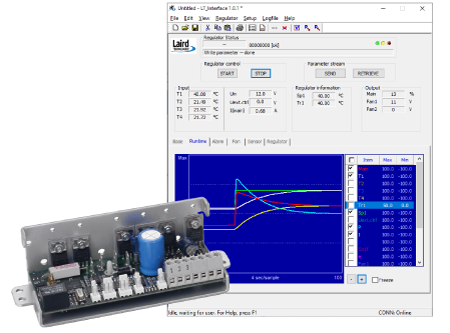 Based on our own developed platforms, Laird Thermal Systems temperature controllers are designed to control thermoelectric cooler assemblies in a closed loop system. Feedback from a temperature sensor is used to vary the output of the controller to maintain the correct temperature of an object or enclosure.
Based on our own developed platforms, Laird Thermal Systems temperature controllers are designed to control thermoelectric cooler assemblies in a closed loop system. Feedback from a temperature sensor is used to vary the output of the controller to maintain the correct temperature of an object or enclosure.
When combined with a temperature controller, Laird Thermal Systems thermoelectric cooler assemblies can achieve a thermal stability of ±0.05°C under steady-state conditions operating in both heating and cooling modes.
Temperature Controller Features
Our temperature controllers can accommodate various features depending on the type of controller.
- Regulator Modes
Laird Thermal Systems temperature controllers can operate in two modes; ON/OFF or PID (Proportional Integral Derivative).
Single and bi-directional thermostatic controllers are used to maintain a constant temperature setpoint, where the tolerance is defined by a hysteresis range. The controller will shut off the thermoelectric cooler assembly once the temperature setpoint is achieved, and then turn on cooling or heating mode if the temperature drops or exceeds the hysteresis range.
Proportional temperature controllers utilize proportional regulation to maintain a constant temperature with no fluctuations. This is accomplished by a PID algorithm determining the output value and a pulse width modulation (PWM) output that control the device.
- Fan Speed Control
Running fans at high speeds to achieve a high cooling capacity can generate a lot of noise. For applications where noise pollution is an important parameter, the controller can adjust the fan speed to minimize the noise. This can be particularly important for thermal applications used in instruments in a lab setting.
- Graphical User Interface
Our PR-59 temperature controller comes with a graphical user interface (GUI), which can be used with a PC to adjust settings and visually review output parameters. Users can view a graph in real-time showing parameters including main power, thermistors, temperature setpoints, input current draw, input voltage to thermoelectric coolers, input power to fans and PID parameters. The alarm, fan, sensor and regulator tabs are used to directly control the device. Learn more about its features in the PR-59 and LT Interface User Manual.
- Sensing and Monitoring
Sensors play a critical role in maintaining a specific temperature setpoint by measuring temperature and providing feedback to the control system. Depending on the customer requirements, different types of sensors can be used including thermistor, pressure, flow , current or voltage. While some parameters are used to directly control the cooling unit, others are used for monitoring critical components and logging system performance over time.
- Alarms
The sensing functionality can be programmed so that it triggers an alarm in critical situations. For example, if the temperature in a chamber exceeds the preprogrammed temperature setpoint, the fan speed is lower than the minimum level or the device pulls more voltage than what is allowed. Available alarm features:
- Low or high voltage alarm
- Max voltage or current alarm
- Low tachometer alarm
- Low or high temperature alarm
- Open circuit alarm
- Critical sensor check during operation
- Data Collection
All parameters that are monitored by the PR-59 graphical interface can be saved to a log file and exported to Excel for further analysis. Users can easily choose sample rate and maximum number of samples to be stored in one log file.
Learn More
Learn more about our temperature controllers for thermoelectric cooler assemblies:
Single Directional Thermostatic
Bi-Directional Thermostatic
Proportional Integral Derivative (PID Programmable)
For any questions related to our thermoelectric temperature controllers, please contact our thermal experts.
